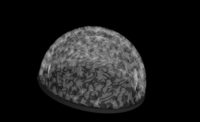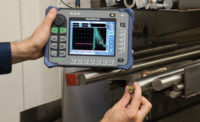Device Monitors Metal Stamping Press

A real-time data acquisition system has enabled a manufacturer of torque converters to increase quality and reduce scrap in its metal stamping operations.
Photo courtesy CAS DataLoggers
A manufacturer of automotive torque converters needed to increase quality and reduce scrap in its metal stamping operations. One of the main parts of the converter is produced on a hydraulic stamping press, which created a series of indentations in a metal ring. In the stamping press, hydraulic cylinders force hardened rectangular punches into the metal blank, displacing the metal into a corresponding die. For the torque converter, the tooling creates 136 indentations in each part.
The converters are produced on an automated line that turns out one part every 45 seconds. While efficient, automation poses a risk that many defective parts could be made before a visual inspection by the press operator detected that the indentations weren’t being properly formed because of a worn punch or one that had failed. To make matters worse, the plant runs multiple punching machines simultaneously, so failures sometimes occurred as often as once per shift. This resulted in a great deal of scrap, since faulty parts cannot be reworked.
To prevent scrap from occurring, plant management needed a highly accurate data acquisition and control device that could continually monitor the punches in real-time for signs of wear and impending breakage. A high-speed, real-time data acquisition system was the answer.

The ADwin-Light-16 is an intelligent, real-time data acquisition and control system with analog and digital I/O, counters and a microprocessor with local memory. Photo courtesy CAS DataLoggers
Keeping Watch
The manufacturer installed a custom system designed by CAS DataLoggers, incorporating an ADwin-Light-16 real-time data acquisition system to measure the force generated during the stamping operation. A pressure sensor was attached to each hydraulic cylinder used to drive the punches, providing data on the punch’s force as the indentation is formed. Data was collected over a period of time to characterize the load signature from a properly operating press. This signal was coded into the ADwin and used as a reference against the real-time signatures collected during production. A start signal from the PLC used to control the press is fed into the ADwin’s digital input to trigger the acquisition cycle. The force waveform is sampled at 1,000 times per second over a period of several seconds during which the indentation is formed.
The ADwin immediately computes the maximum and minimum force and compares it to a stored load signature. If the operating curve is outside of the programmed tolerance, the ADwin uses a digital output to send a signal to the PLC to indicate that there is a problem and to stop the machine. This eliminated the production of defective parts that have to be scrapped.

An onboard SHARC digital signal processor with its own local memory handles system management, data acquisition, on-line processing and control of outputs. Processing of each measurement can occur immediately after acquisition. Photo courtesy CAS DataLoggers
This ADwin-Light-16 features eight 16-Bit analog inputs, of which three are used to sample the pressure signal from the three hydraulic cylinders in the press. Two of the six digital I/O are used for the interface to the PLC controlling the press. The system also has a 32-bit SHARC real-time digital signal processor with its own local memory to handle data acquisition, online statistical processing, and control of outputs.
Real-time development was performed using ADbasic software. With ADbasic, engineers can easily create event-driven applications to capture and process data, generate output signals, and provide open- or closed-loop control. ADbasic’s functionality allows access to all the ADwin’s I/O, as well as implementing calculations, logic and communication with a PC.
The automotive manufacturer benefited significantly following the installation of the custom ADwin system for production monitoring. The system provides real-time monitoring of the stamping operations and allows the plant’s broken punches to be detected immediately, greatly reducing scrap costs and wasted time. And, as more data was collected it became possible to identify tooling that had become worn prior to failure, which further reduced scrap and machine downtime. The early-warning system also reduced the once-constant need for operators to inspect each part for defects. The ADwin system provided a near-immediate ROI and greatly increased quality.
For more information, visit www.dataloggerinc.com.
Looking for a reprint of this article?
From high-res PDFs to custom plaques, order your copy today!






